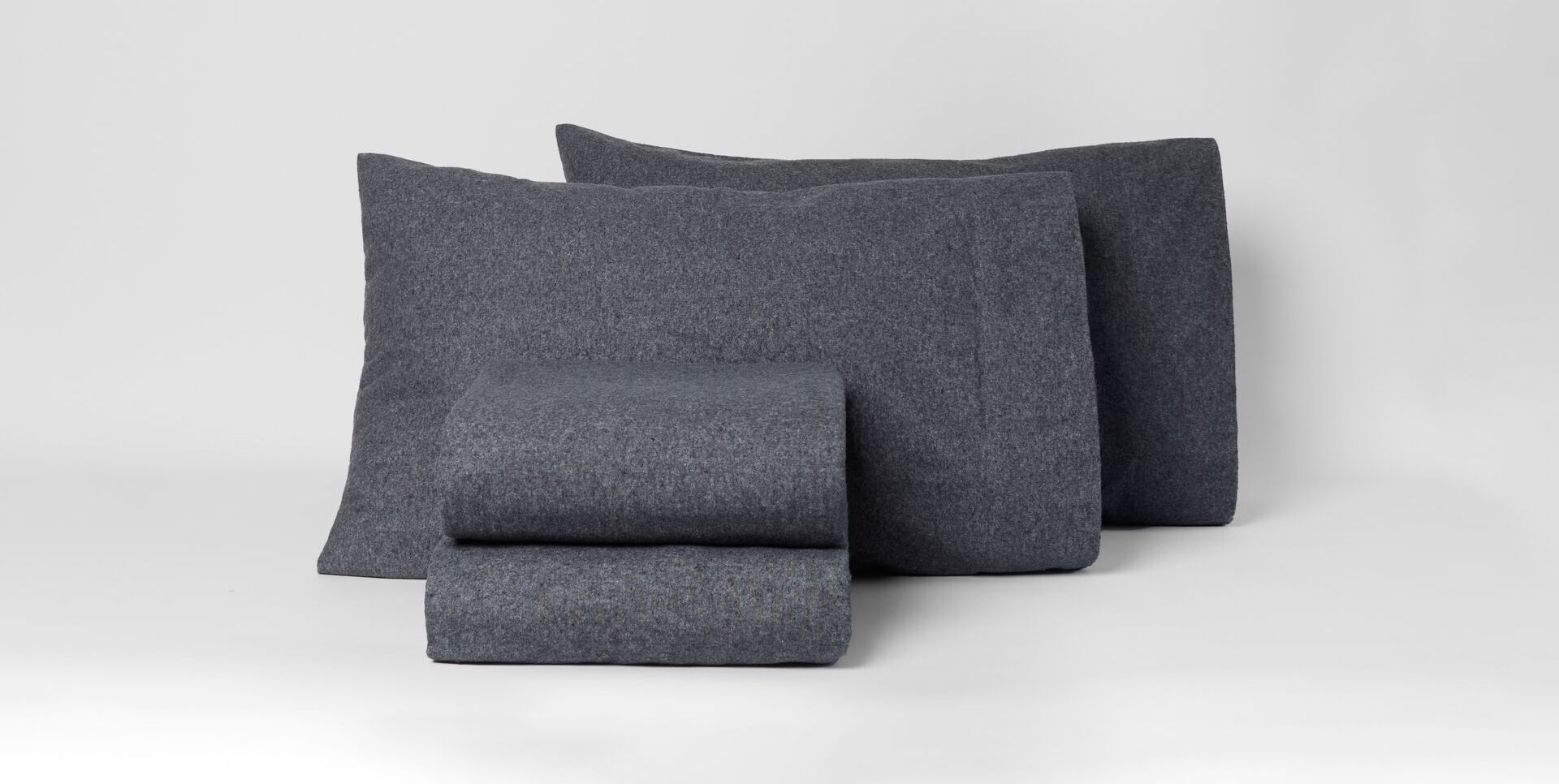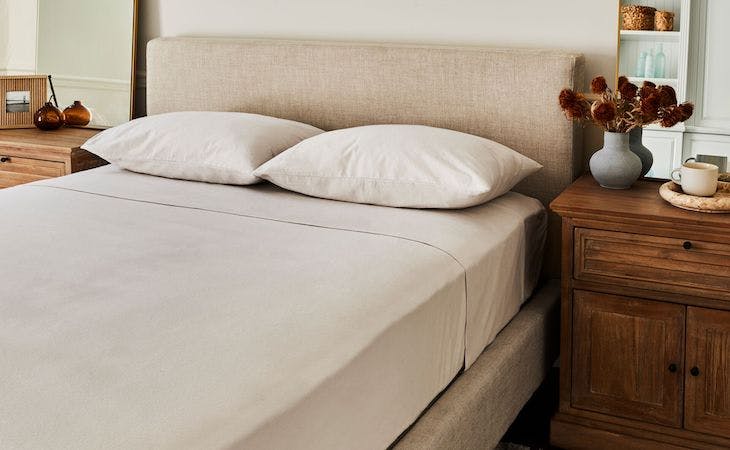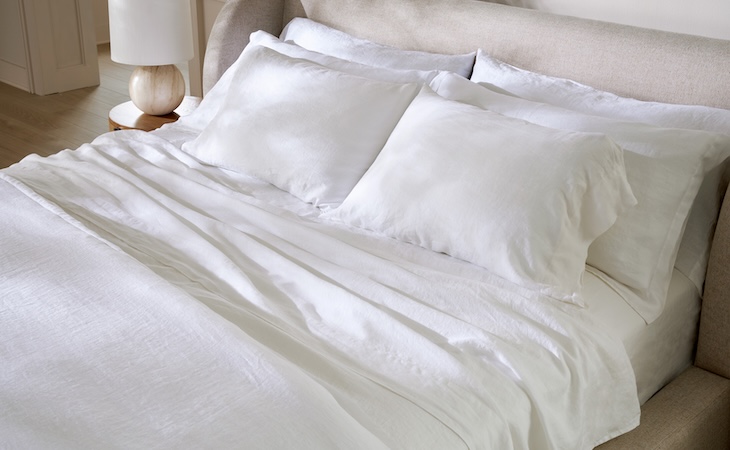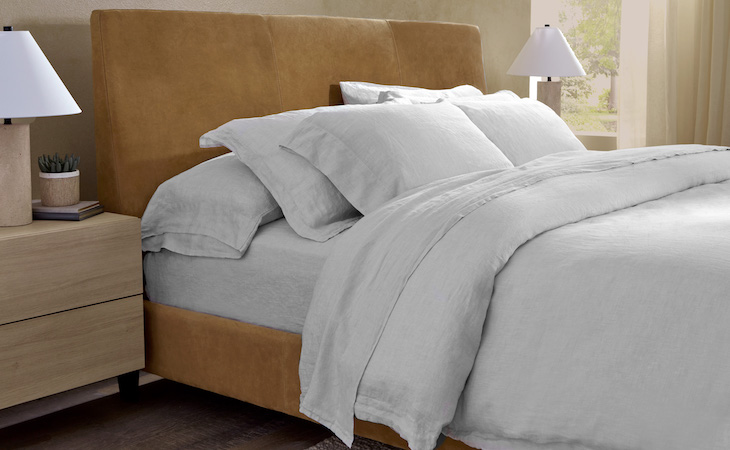Now that the days are getting shorter and the nights are getting chillier, you might have started thinking about ways to feel cozier at night.
Rugs on the floor, thermal curtains on the window, and a heavier duvet will all go a long way toward keeping you toasty while helping you save on heating costs. Another favorite winter warmer: flannel sheets.
Most of us are familiar with the warm and fuzzy feel of flannel. But what is flannel, exactly? And are all flannel sheets created equally? Here’s how to choose flannel sheets for your most comfortable sleep yet.
What is flannel?
Flannel is a loosely knit fabric that can be made of wool, cotton, or synthetic fibers. It most likely originated in Scotland and Wales in the 16th century, when it was made out of brushed wool. After the Industrial Revolution, this fabric made its way to the United States, where cotton became the most popular flannel material.
How flannel is produced
Flannel gets its fuzzy feel through a process called napping. That’s when a woven sheet of fabric is passed over heavy cylinders covered with thousands of fine metal teeth that brush the fabric, pulling tiny, fine fibers from it. This creates millions of little insulating air pockets that trap heat and keep you warm.
Flannel may be brushed on one side or both, or it can be unbrushed. Double-napped flannel (flannel that’s brushed on both sides) is considered to be of the highest quality. High-quality flannel is soft and fuzzy but not bulky. Finer flannel will be more durable and less prone to pilling than bulky flannel.
Unlike other fabrics, flannel quality isn’t judged by thread count but by weight (grams per square meter, or GSM). The higher the GSM, the warmer and better quality the sheets. 170 GSM is considered high-quality flannel and will be quite warm.
The country of origin matters too. Most high-quality flannel comes from England, Germany, or Portugal. Portugal, in particular, has a long tradition of creating flannel from long-staple cotton and produces some of the softest flannel out there. German and English flannel will typically have a denser feel.
The pros and cons of flannel sheets
Pros
There are quite a few benefits to sleeping on flannel sheets. Here are the top ones:
- Flannel is warm. Sleeping on high-quality flannel sheets will help keep you warm during the night without the need to crank up your thermostat. Flannel is able to keep you warm because it’s made via a process called “napping,” which creates insulating air pockets on the surface of the sheet that trap body heat. If you’re worried about flannel sleeping too hot, look for sheets made of 100% cotton flannel. Like all cotton bedding, cotton flannel is breathable and great at absorbing moisture and wicking it away from your body.
- Flannel is super-soft. High-quality flannel feels fuzzy and extremely soft to the touch. Keep in mind that low-quality flannel, however, can feel rough against your skin.
- Flannel is durable. If you follow the manufacturer’s instructions and take good care of your flannel sheets, a high-quality set should last for years.
Cons
There are also some drawbacks of flannel sheets to consider, including the following:
- Flannel can be too warm for some. While helping you stay warm is one of its key selling points, some people may find that flannel is too warm. This is particularly the case for flannel sheets made from synthetic material. If you sleep hot, then you may want to consider a more breathable sheet material, such as percale or linen.
- Flannel can shrink. Cotton flannel sheets can shrink slightly. On the other hand, flannel sheets made from a cotton blend won’t have this problem.
- Flannel can pill. Flannel sheets (especially cotton/polyester blends) have the tendency to pill. That said, a proper care and maintenance routine can help prevent that.
What types of flannel sheets are available?
Today, flannel can be made from cotton, synthetic fibers, or a blend of the two. Less commonly it can also be made of wool.
Cotton
Cotton is the most common flannel material. It’s highly breathable and absorbs moisture well (which is a must for people who tend to sweat a lot at night). Cotton flannel sheets feel soft and dry. Keep in mind that 100% cotton flannel sheets may shrink a bit after the first couple of washings.
Microfiber
Synthetic flannel is made from very fine, tightly woven polyester fibers and is often called micro-flannel. The good news about micro-flannel is that it sheds less lint than cotton flannel and won’t shrink in the wash.
It may also feel softer than some cotton flannel because synthetic yarn contains more tiny fibers than cotton that are raised during napping, and it maintains the fuzzy feel for longer.
But synthetic flannel can’t compete with cotton in terms of breathability and moisture-wicking properties.
Cotton/polyester blend
Some flannel is a blend of cotton and polyester. These sheets will have some of the qualities of both materials: They’ll be more breathable than purely synthetic flannel but won’t shrink as much as 100% cotton flannel will.
The drawback is that these sheets will be a lot more prone to pilling. That’s because polyester tends to make the cotton fibers tougher, which creates many tiny fiber clusters (pills) that’ll remain stuck to the base fabric.
Wool
Wool flannel sheets are harder to find these days and often can only be made to order. If you crave the feel of wool, it’ll be easier to achieve that by getting a wool flannel blanket or a wool-based mattress pad.
How to choose flannel sheets
When looking for the best flannel sheets, here are the top factors to keep in mind during the shopping process:
Material
Flannel sheets can be made from different materials, including cotton, wool, and polyester. Cotton is the most common flannel sheet material and is soft, breathable, and moisture-wicking.
Flannel sheets made from polyester, meanwhile, are wrinkle- and stain-resistant—but they won’t be as breathable. Cotton/polyester blends offer a nice mix between cotton and polyester flannel sheets.
Wool flannel sheets, on the other hand, are warm and soft—but they’re harder to find.
Weight
Flannel quality is judged by weight (GSM). The higher the GSM, the higher the quality—and the warmer the sheets. To choose the best flannel sheets, look for 170 GSM or higher.
Flannel sheets with 170 GSM or higher will be heavier and warmer, while flannel sheets with a lower GSM will be more lightweight and breathable.
Feel
Flannel is known for its soft and fuzzy feel. This feeling is a result of a process called napping, which involves brushing the fabric after it’s woven. Flannel can be napped on one side or both sides.
Double-napped flannel, which is brushed on both sides, is incredibly soft and considered the highest quality flannel.
Breathability
Flannel sheets are quite warm, but you can ensure breathability by choosing ones made from long-staple fibers. These allow for more airflow.
The type of material you choose can determine breathability too. Cotton and wool are both breathable, while polyester and other synthetic fibers aren’t.
Style
Flannel sheets come in a variety of colors and patterns to suit your bedroom style. Choose from neutral solid hues to quintessentially flannel plaid patterns and beyond.
Durability
In general, flannel sheets are pretty durable, so you won’t have to worry too much about wear and tear. Just keep in mind that due to the napping process, flannel can be more prone to pilling.
Price
Expect to spend upwards of $200 on high-quality 100% cotton flannel sheets, depending on the size. Synthetic and blend flannel will typically be less expensive.
Maintenance
Always follow the manufacturer’s instructions when washing flannel sheets. Wool flannel is usually dry clean only. Cotton and synthetic flannel should be washed with cold or warm water on a gentle cycle.
Don’t use fabric softener, as this will actually stiffen the fabric and reduce the softness of the sheets over time. Air dry if you can, or put the sheets in the dryer at a low temperature.
FAQs
What thread count is best for flannel sheets?
Thread count isn’t important when it comes to flannel sheets. Instead, look at the weight (measured in grams per square meter, or GSM) of the material to get a sense of quality. Flannel sheets with a 170 GSM or higher are considered the highest quality.
Are there different weights of flannel sheets?
Flannel sheets are measured by weight (grams per square meter, or GSM). Typically, the higher the weight, the heavier, warmer, and more durable the flannel sheets. Look for a weight of 170 GSM or higher for the best quality.
What is a good GSM for flannel sheets?
Anything 170 or higher is considered a good GSM for flannel sheets. Flannel sheets with a 170 GSM or greater will be warm and durable.
How can you tell good quality flannel?
High-quality flannel will be fuzzy, soft to the touch, and have some heft to it. It will also be made out of 100% cotton to keep you warm while maintaining breathability. Finally, high-quality flannel will have a weight of 170 GSM or higher.
Shop Saatva’s flannel sheets
Now that you know all about the benefits of sleeping on flannel and how to choose flannel sheets, it’s time to shop.
Saatva’s

Heirloom-quality flannel cotton sheets with a velvety-soft feel
is made from 100% long-staple cotton, with a 180 GSM, for a more breathable style that still retains warmth. The brushed, velvety finish makes them super-soft while reducing wear and pilling.
Wrap yourself in our flannel sheets for a warm and cozy sleep this winter and beyond.




